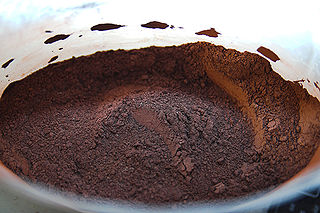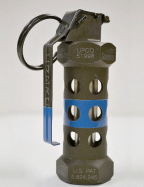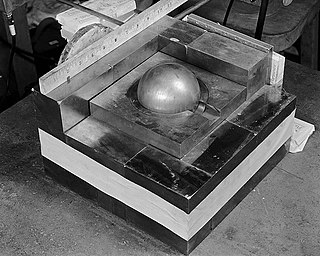Related Research Articles

An explosive is a reactive substance that contains a great amount of potential energy that can produce an explosion if released suddenly, usually accompanied by the production of light, heat, sound, and pressure. An explosive charge is a measured quantity of explosive material, which may either be composed solely of one ingredient or be a mixture containing at least two substances.

Magnesium is a chemical element with the symbol Mg and atomic number 12. It is a shiny gray solid which bears a close physical resemblance to the other five elements in the second column of the periodic table: all group 2 elements have the same electron configuration in the outer electron shell and a similar crystal structure.

Polytetrafluoroethylene (PTFE) is a synthetic fluoropolymer of tetrafluoroethylene that has numerous applications. The commonly known brand name of PTFE-based compositions is Teflon by Chemours, a spin-off from DuPont, which originally discovered the compound in 1938.

Thermite is a pyrotechnic composition of metal powder and metal oxide. When ignited by heat or chemical reaction, thermite undergoes an exothermic reduction-oxidation (redox) reaction. Most varieties are not explosive, but can create brief bursts of heat and high temperature in a small area. Its form of action is similar to that of other fuel-oxidizer mixtures, such as black powder.

Nuclear weapon designs are physical, chemical, and engineering arrangements that cause the physics package of a nuclear weapon to detonate. There are three existing basic design types:
A substance is pyrophoric if it ignites spontaneously in air at or below 54 °C (129 °F) or within 5 minutes after coming into contact with air. Examples are iron sulfide (FeS) and many reactive metals including plutonium and uranium, when powdered or thinly sliced. Pyrophoric materials are often water-reactive as well and will ignite when they contact water or humid air. They can be handled safely in atmospheres of argon or nitrogen. Class D fire extinguishers are designated for use in fires involving pyrophoric materials.

Flash powder is a pyrotechnic composition, a mixture of oxidizer and metallic fuel, which burns quickly and if confined produces a loud noise. It is widely used in theatrical pyrotechnics and fireworks and was once used for flashes in photography.

Military vehicles are commonly armoured to withstand the impact of shrapnel, bullets, shells, rockets, and missiles, protecting the personnel inside from enemy fire. Such vehicles include armoured fighting vehicles like tanks, aircraft, and ships.
Thermate is a variation of thermite and is an incendiary pyrotechnic composition that can generate short bursts of very high temperatures focused on a small area for a short period of time. It is used primarily in incendiary grenades.
Nano-thermite or super-thermite is a metastable intermolecular composite (MICs) characterized by a particle size of its main constituents, a metal and a metal oxide, under 100 nanometers. This allows for high and customizable reaction rates. Nano-thermites contain an oxidizer and a reducing agent, which are intimately mixed on the nanometer scale. MICs, including nano-thermitic materials, are a type of reactive materials investigated for military use, as well as for general applications involving propellants, explosives, and pyrotechnics.
A pyrotechnic composition is a substance or mixture of substances designed to produce an effect by heat, light, sound, gas/smoke or a combination of these, as a result of non-detonative self-sustaining exothermic chemical reactions. Pyrotechnic substances do not rely on oxygen from external sources to sustain the reaction.
Magnalium is an aluminium alloy with 5% magnesium and 95% aluminum.
Magnesium/Teflon/Viton (MTV) is a pyrolant. Teflon and Viton are trademarks of DuPont for polytetrafluoroethylene, (C2F4)n, and fluoroelastomer, (CH2CF2)n(CF(CF3)CF2)n.
A pyrolant is an energetic material that generates hot flames upon combustion. Pyrolants are metal-based pyrotechnic compositions containing virtually any oxidizer. The term was originally coined by Kuwahara in 1992, in a paper on magnesium/Teflon/Viton, to distinguish between compositions that serve as propellants and those yielding hot flames which are not necessarily suitable for propellant purposes.

The M84 is the currently-issued stun grenade ("flashbang") of the United States Armed Forces and SWAT teams throughout the United States. Upon detonation, it emits an intensely loud "bang" of 170–180 decibels and a blinding flash of more than one million candela within 5 feet of initiation, sufficient to cause immediate flash blindness, deafness, tinnitus, and inner ear disturbance. Exposed personnel experience disorientation, confusion and loss of coordination and balance. While these effects are all intended to be temporary, there is risk of permanent injury. Consequently, the M84 is classified as a less-lethal weapon.

A flare or decoy flare is an aerial infrared countermeasure used by a plane or helicopter to counter an infrared homing ("heat-seeking") surface-to-air missile or air-to-air missile. Flares are commonly composed of a pyrotechnic composition based on magnesium or another hot-burning metal, with burning temperature equal to or hotter than engine exhaust. The aim is to make the infrared-guided missile seek out the heat signature from the flare rather than the aircraft's engines.
The Ames process is a process by which pure uranium metal is obtained. It can be achieved by mixing any of the uranium halides with magnesium metal powder or aluminium metal powder.
A pyrotechnic initiator is a device containing a pyrotechnic composition used primarily to ignite other, more difficult-to-ignite materials, e.g. thermites, gas generators, and solid-fuel rockets. The name is often used also for the compositions themselves.

The pit, named after the hard core found in fruits such as peaches and apricots, is the core of an implosion nuclear weapon – the fissile material and any neutron reflector or tamper bonded to it. Some weapons tested during the 1950s used pits made with U-235 alone, or in composite with plutonium, but all-plutonium pits are the smallest in diameter and have been the standard since the early 1960s.
Reactive multi-layer foils are a class of reactive materials, sometimes referred to as a pyrotechnic initiator of two mutually reactive metals, sputtered to form thin layers that create a laminated foil. On initiation by a heat pulse, delivered by a bridge wire, a laser pulse, an electric spark, a flame, or by other means, the metals undergo self-sustaining exothermic reaction, producing an intermetallic compound. The reaction occurs in solid and liquid phase only, without releasing any gas.
References
- ↑ Committee on Advanced Energetic Materials and Manufacturing Technologies, National Research Council (2004). Advanced Energetic Materials. Washington D.C., USA: National Academies Press. pp. 20–23. ISBN 978-0-309-09160-2 . Retrieved 16 August 2011.
- ↑ Patents https://www.google.fr/patents/US7191709 and https://www.google.fr/patents/US7194961 make explicit reference to the use of uranium
- ↑ USpatent 6593410,Nielson, Daniel B.; Tanner, Richard L.& Lund, Gary K.,"High Strength Reactive Materials",published 2003-05-22,issued 2003-07-15, assigned to Alliant Techsystems Inc.
- ↑ USpatent 6962634,Nielson, Daniel B.; Truitt, Richard M.& Rasmussen, Nikki,"Low temperature, extrudable, high density reactive materials",published 2004-02-05,issued 2005-11-08, assigned to Alliant Techsystems Inc.
- ↑ "Reactive Material Structures (RMS)". Defense Advanced Research Projects Agency. Retrieved 16 August 2011.